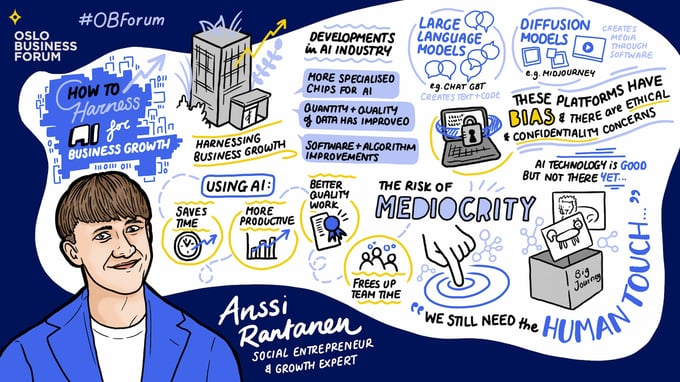At Oslo Business Forum, Anssi revealed the immense potential of AI and helped business leaders understand how to navigate the AI landscape. He provided valuable insight into the rapid pace of generative AI advancements and how harnessing the power of AI can help leaders enhance efficiency and unlock growth.
Humans have been envisioning computer knowledge for quite some time. Anssi described a late 1800s magic trick in which a magician built a “machine” that could beat anyone at the game of chess. No one knew how it worked until a theater fire disrupted one of the magician’s performances. As the building evacuated, the audience saw a little man crawl out from beneath the table, revealing the magician’s secret. This was one of the first visions of artificial intelligence.
Advances in Generative AI
“Computers quite recently were incredibly dumb,” said Anssi. However, problems that AI was previously unable to solve (like identifying if an image was a chihuahua or a muffin) have become very simple.

Anssi Rantanen is a growth expert and serial entrepreneur. He has helped more than 100 companies execute growth strategies, and he talks to business leaders about what the fastest-growing companies in the world do differently. Continuous learning and rapid experimentation are at the heart of the new ways of driving growth.
Three things are driving the advances in generative AI technology:
1. Hardware improvements (chips).
2. Quantity and quality of training data.
3. Algorithmic improvements (software).
Anssi explained the two most important and relevant algorithmic software models behind generative AI today:
Large Language Models (LLMs) power generative AI, giving it vast amounts of text to study, and the machine learns to predict the next word. It assists in text generation, as well as translation and summarization.
Diffusion models are software algorithms that can create images, video, and audio files out of nothing. The software has evolved rapidly, and Midjourney is the most popular tool using the diffusion model.
Anssi listed a number of challenges that exist with these models today:
1. Potential biases.
2. Hallucinations.
3. Cost of training and cost of use.
4. Interpretability.
5. Data security.
6. Copyright issues.
7. Use for malicious purposes.
Despite these risks and challenges, Anssi is adamant that businesses should still experiment with these incredibly powerful technologies.
The Proof: AI Case Studies
Anssi led the audience through several eye-opening case studies demonstrating how generative AI has impacted real businesses.
My Speaker estimated their salespeople spent 20% of their time looking for speaker information. They developed an AI co-pilot that provides recommendations, saving each salesperson 30-45 minutes daily, translating to $100,000 in savings annually.
Boston Consulting Group (BCG) gave a subset of its consultants a generative AI tool and withheld it from another set of consultants. When the output of the two groups was compared, the subset using AI had completed 12% more work, and the quality of their work increased by 40%.
jetBlue developed an AI-powered chatbot that can answer 60,000 questions. They’ve estimated this tool saves their customer service representatives 73,000 hours each quarter, translating to a bottom-line improvement of $2.2 million quarterly. It also allows representatives to spend more time with customers, creating a win-win.
At GitHub, a generative AI co-pilot specialized for software development has increased developer productivity by 126%.
There are currently more than 1,000 AI startups being started every month. This has interesting implications for businesses. Anssi’s take on the most important implication? “Mediocrity is dead,” he said.
Using the tools available today, anyone can create a mediocre website, sales presentation, or business plan in seconds or minutes. “Generative AI is good at creating 60% versions of anything in seconds or minutes, and there is huge efficiency to be gained from this,” he said.
“But you can’t forget the last 40%. The human touch.”
As humans, we crave magical experiences, and businesses want to create raving fans. Generative AI cannot do this yet.

A Magic Trick
To demonstrate where we are with generative AI, Anssi co-created a magic trick with ChatGPT. He introduced an off-line version of Midjourney that he calls Big Journey. He asked a member of the audience to choose a number between 1 and 100, corresponding to a random list of animals. Number 64 corresponded to a lion, so Anssi asked Big Journey to produce an image of a lion. Its first attempt was average, but its second attempt was excellent.
Anssi revealed that he did not actually use ChatGPT to create this astounding magic trick. Instead, he partnered with a talented Nordic magician who invisibly assisted. Why? Because he wanted his trick to be more than mediocre; he wanted it to be exceptional.
Anssi left leaders at Oslo Business Forum with advice: “Let’s not be content with mediocrity,” he said. “Let’s strive to be exceptional. When you combine the two, that’s where the magic happens.”
Key Points
- A Generative AI today is powered by two algorithmic models: Large Language Models (LLMs) and diffusion models.
- There are several risks associated with AI experimentation, but also opportunities. Use cases demonstrate significant efficiency gains and top- and bottom-line savings.
- Generative AI is good at creating 60% versions of anything in seconds or minutes. The last 40% requires human touch.
- Businesses can benefit from generative AI, but leaders must not lose sight of the real value they deliver to customers: magical experiences.
Questions to Consider
- Have you experimented with generative AI? How might this experimentation help your business?
- Which tasks or processes in your business can be completed more efficiently using AI?
- What would a 60% output look like for your business? What contributes to the remaining 40%
Want to be a part of the OBF community? Join Oslo Business Forum 2024: Courageous Leadership now!
